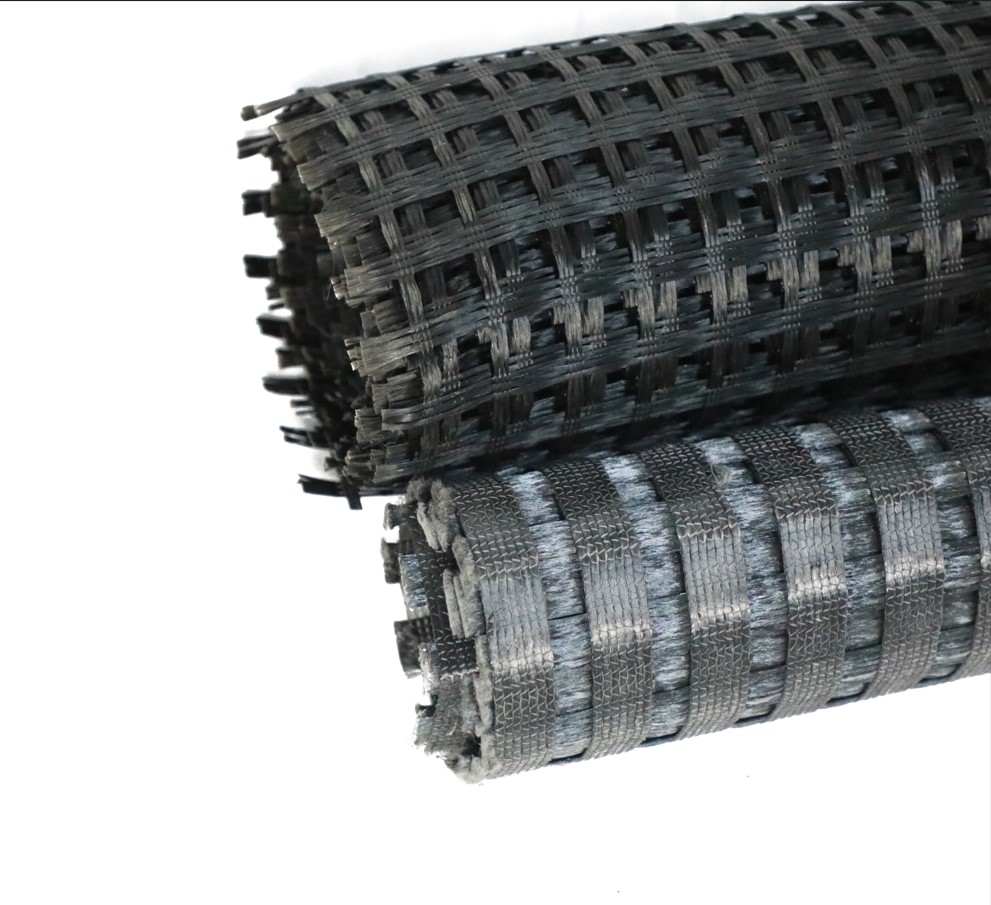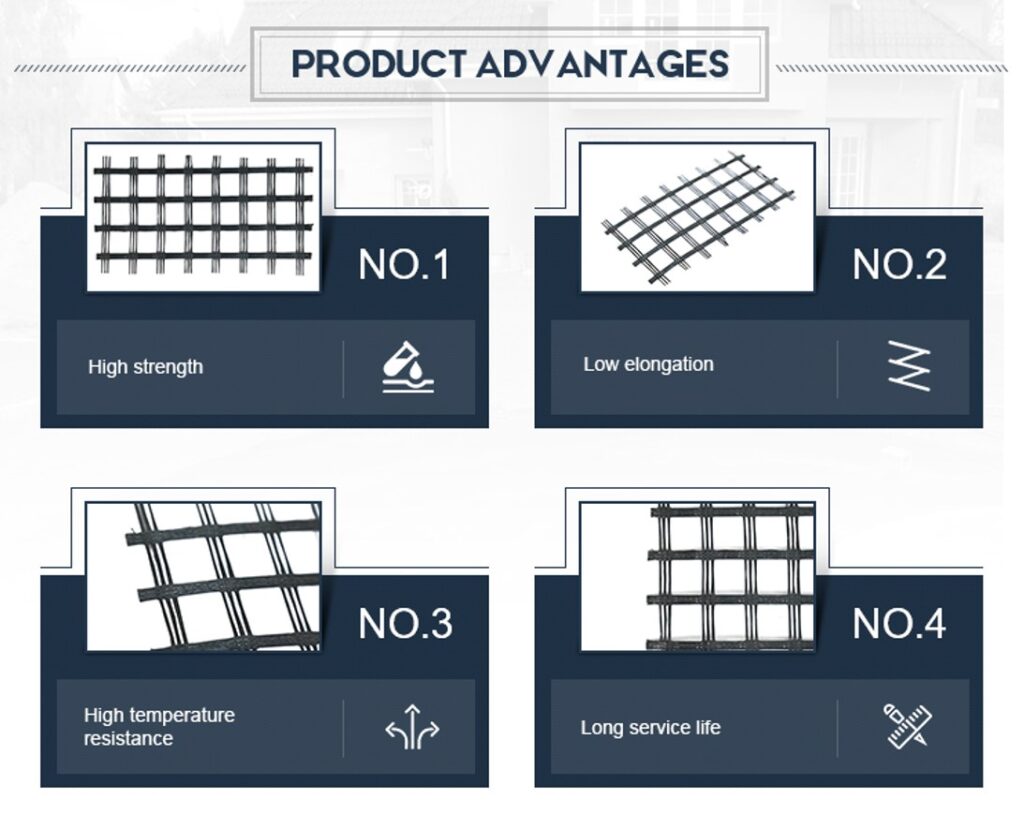Geogrid Construction Work Instructions
1.Scope of application
It is suitable for roadbed reinforcement geogrid construction.
2.Homework preparation
2.1 The layered embankment is rolled and compacted intact, and the flatness meets the specification requirements.
2.2 Organize technical and relevant personnel to study design documents and related construction technical specifications, and technical personnel to conduct technical disclosure and on-site drawing and stakeout.

3.Technical requirements
3.1 When the filling height reaches the design elevation for laying geogrid, measure and set out the line on the qualified filling surface, and determine the position of laying geogrid according to the design requirements.
3.2 The overlapping of geogrids must meet the requirements of technical specifications.
4.Construction procedures and technological process
4.1 Construction preparation
( 1 ) Measurement and setting out and site clearing
Measure and stake out the construction site according to the construction specifications and design requirements.
( 2 ) Material preparation
The geogrid used for embankment side slope reinforcement adopts two-way geogrid. The width of geogrid should not be less than 2.5m, the tensile strength should not be less than 25KN/m, and the elongation should be ≤10%.
The geogrid used for soft foundation reinforcement using pile-net composite foundation adopts two-way geogrid, and high-strength polypropylene material is selected for soft foundation reinforcement. The tensile strength is determined according to calculation, but generally not less than 80KN/m. Width ≥ 5.0m, elongation ≤ 8%.
Before the geogrid is laid, the performance of each batch of products is tested by a qualified product quality supervision and inspection center authorized by the state. The testing frequency is not less than 3 groups, and it can be laid only after passing the test. The quality should meet the requirements of various national industry standards.
4.2 Construction method
(1) Lay within the measured range. The geogrid is paved on the subgrade, and the outer edge is generally 0.6m away from the side slope, and the laying width is set according to the design requirements.
(2) Wrinkles are not allowed during laying, and it must be tightened and closely adhered to the roadbed surface. After paving, use U-shaped iron nails or bamboo nails to fix it.
(3) When laying geogrids, the surface of the soil layer should be flat without hard protrusions. After laying, it should be filled with sand and covered in time to avoid direct exposure to the sun for a long time.
(4) On the slope ground, a 2.5-4.5m wide platform shall be dug on the ground at the foot of the slope.
(5) When laying multi-layer geogrid, the upper and lower joints should be staggered alternately, and the stagger distance should not be less than 0.5m.
(6) The geogrid shall not be laid directly on the hard underlying layer such as gravel, and a 5cm-thick medium-coarse sand protective layer shall be laid between the geogrid and the gravel.
5.Construction requirements
5.1 The original ground shall be cleaned and rolled, and the base treatment shall be the same as that of the general subgrade filling construction.
5.2 After the geogrid is rolled out, the filler should be filled in time. When the filler is not laid, mechanical vehicles are not allowed to walk on it.
6.labor organization
Staffing table for each job site
7.Material requirements
Geosynthetic material specifications and properties, longitudinal tensile strength, elongation, etc. meet the design and specification requirements.
8.Equipment configuration
The main machinery and equipment are equipped with transport vehicles.
9.Quality control and inspection
9.1 Quality Control
(1) The quality of raw materials shall be randomly inspected according to the specified frequency and standards, and protection shall be strengthened during construction to prevent pollution and damage.
(2) The surface of the underlying layer of geosynthetics should be leveled and compacted, and hard protrusions on the surface should be removed.
(3) When laying geosynthetics, the direction with high strength should be placed in the main stress direction of the embankment, and it should be laid according to the design when there are special requirements in the design.
(4) After the geosynthetics are paved, the folded section shall be paved according to the design requirements, and shall be covered with sand in time.
(5) It is strictly forbidden to roll and transport equipment to directly roll or walk on the geosynthetics.
(6) Lap joint and anchorage width meet the requirements.
(7) The original ground drainage should form a 4% road crown.
(8) The laying of geosynthetics is a concealed project. During the construction process, quality inspectors should monitor the site and make a record of the concealed project inspection. The next process can only be carried out after being signed by the supervisor.
9.2 Quality inspection methods and frequency
Quality inspection method and frequency

10.Safety and environmental requirements
10.1 Safety requirements
10.1.1 Clear signs shall be set up on the construction work site. Idlers are not allowed to enter the heavy construction site. When entering the construction site, safety helmets must be worn to prevent falling objects.
10.1.2 For safe use of electricity, the switchboard should be strictly protected, and leakage protection devices should be installed to prevent leakage. The wires used should not be pulled around without permission. Always check the circuit system for potential problems such as broken skin, leakage, and short circuit.
10.1.3 Non-mechanical operators are not allowed to operate mechanical construction, and must hold a certificate to work. During construction at night, sufficient lighting shall be provided to strengthen safety management. During the construction period, do a good job in fire prevention, anti-theft safety and security work, and work after drinking is strictly prohibited.
10.2 Environmental requirements
10.2.1 Construction personnel entering the construction site must be neatly dressed; construction personnel must wear work permits to work.
10.2.2 Temporary drainage and waste debris in the construction site shall be cleared out in time, no littering is allowed, and attention shall be paid to the cleanliness of the construction site.
10.2.3 Strengthen the protection of the environment during construction, avoid the cut geogrid scattered everywhere, and prevent rain from flowing into farmland and rivers.
